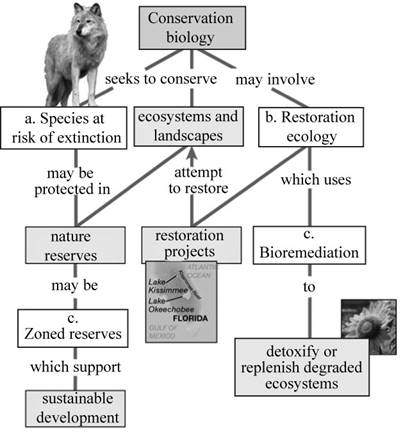
Concept explainers
To complete: The map which organizes some of the key concepts of conservation biology.
Introduction:
The key concepts and themes of conservation biology include:
Concept 1:“Prevention of the extinction of the endangered species”.
Concept 2: “Projects to restore and conserve ecology”.
Concept 3: “Bioremediation”.
Concept 4:“Formation of zoned reserves for the preservation of the species of plants and animals”.
Answer to Problem 1CC
Pictorial representation:
Fig no.1 shows the completed map of the key concepts of conservation biology.

Fig.1: Key concepts of conservation biology.
Explanation of Solution
(a)
Correct answer: Species at risk of extinction.
Explanation:
The species of various plants and animals are preserved in various ecological habitats to prevent them from getting endangered and extinct. The branch of biology used to study this is called as “conservation biology”. Hence the correct answer is species at risk of extinction.
(b)
Correct answer: Restoration ecology.
Explanation:
The destruction of the habitat of animal and plant species due to pollution, hunting of animals, natural calamities like floods, afforestation or the cutting of the forests and over-grazing by animals causes the inability to breed. The branch of biology, which includes the reestablishment of the natural
(c)
Correct answer: Bioremediation.
Explanation:
The process of regeneration of the natural habitat, ecosystem, and preservation of the fertility of soil by planting trees leads to the preservation of the climate and habitat of the plants and animals. The study of this field of biology is called as “Bioremediation”. Hence, the correct answer is bioremediation.
(d)
Correct answer: Zoned reserves.
Explanation:
The preservation of the species of plantsand animals is done in the zoned reserves, where they are preserved by providing regular food and shelter. Hence, the correct answer is zoned reserves.
Want to see more full solutions like this?
Chapter 38 Solutions
CAMPBEL BIOLOGY:CONCEPTS & CONNECTIONS
- Molecular Biology Question You are working to characterize a novel protein in mice. Analysis shows that high levels of the primary transcript that codes for this protein are found in tissue from the brain, muscle, liver, and pancreas. However, an antibody that recognizes the C-terminal portion of the protein indicates that the protein is present in brain, muscle, and liver, but not in the pancreas. What is the most likely explanation for this result?arrow_forwardMolecular Biology Explain/discuss how “slow stop” and “quick/fast stop” mutants wereused to identify different protein involved in DNA replication in E. coli.arrow_forwardMolecular Biology Question A gene that codes for a protein was removed from a eukaryotic cell and inserted into a prokaryotic cell. Although the gene was successfully transcribed and translated, it produced a different protein than it produced in the eukaryotic cell. What is the most likely explanation?arrow_forward
- Molecular Biology LIST three characteristics of origins of replicationarrow_forwardMolecular Biology Question Please help. Thank you For E coli DNA polymerase III, give the structure and function of the b-clamp sub-complex. Describe how the structure of this sub-complex is important for it’s function.arrow_forwardMolecular Biology LIST three characteristics of DNA Polymerasesarrow_forward
- Molecular Biology RNA polymerase core enzyme structure contains what subunits? To form holo enzyme, sigma factor is added to core. What is the name of the structure formed? Give the detailed structure of sigma factor and the function of eachdomain. Please help. Thank youarrow_forwardMolecular Biology You have a single bacterial cell whose DNA is labelled with radioactiveC14. After 5 rounds of cell division, how may cells will contain radioactive DNA? Please help. Thank youarrow_forward1. Explain the structure and properties of atoms and chemical bonds (especially how they relate to DNA and proteins). Also add some pictures.arrow_forward
- 1. In the Sentinel Cell DNA integrity is preserved through nanoscopic helicase-coordinated repair, while lipids in the membrane are fortified to resist environmental mutagens. also provide pictures for this question.arrow_forwardExplain the structure and properties of atoms and chemical bonds (especially how they relate to DNA and proteins). Also add some pictures.arrow_forwardIn the Sentinel Cell DNA integrity is preserved through nanoscopic helicase-coordinated repair, while lipids in the membrane are fortified to resist environmental mutagens. also provide pictures for this question.arrow_forward
 Concepts of BiologyBiologyISBN:9781938168116Author:Samantha Fowler, Rebecca Roush, James WisePublisher:OpenStax College
Concepts of BiologyBiologyISBN:9781938168116Author:Samantha Fowler, Rebecca Roush, James WisePublisher:OpenStax College Biology Today and Tomorrow without Physiology (Mi...BiologyISBN:9781305117396Author:Cecie Starr, Christine Evers, Lisa StarrPublisher:Cengage Learning
Biology Today and Tomorrow without Physiology (Mi...BiologyISBN:9781305117396Author:Cecie Starr, Christine Evers, Lisa StarrPublisher:Cengage Learning Biology (MindTap Course List)BiologyISBN:9781337392938Author:Eldra Solomon, Charles Martin, Diana W. Martin, Linda R. BergPublisher:Cengage Learning
Biology (MindTap Course List)BiologyISBN:9781337392938Author:Eldra Solomon, Charles Martin, Diana W. Martin, Linda R. BergPublisher:Cengage Learning Biology: The Dynamic Science (MindTap Course List)BiologyISBN:9781305389892Author:Peter J. Russell, Paul E. Hertz, Beverly McMillanPublisher:Cengage Learning
Biology: The Dynamic Science (MindTap Course List)BiologyISBN:9781305389892Author:Peter J. Russell, Paul E. Hertz, Beverly McMillanPublisher:Cengage Learning





